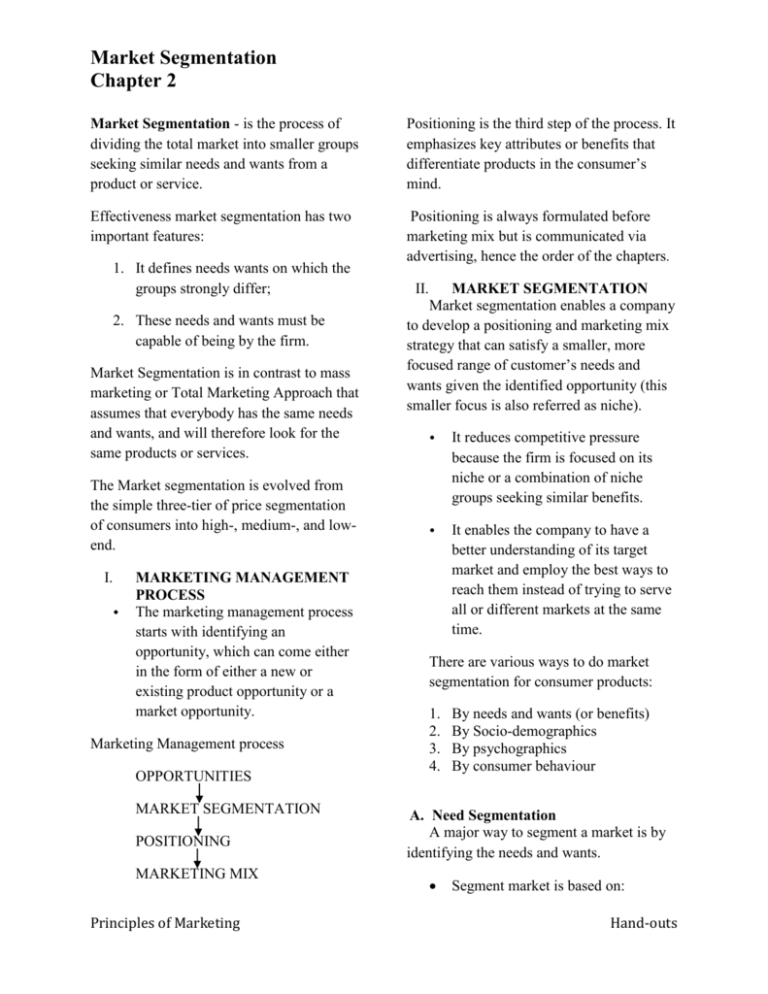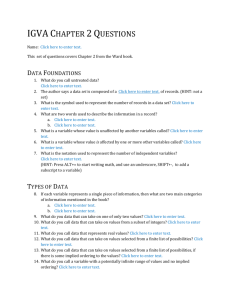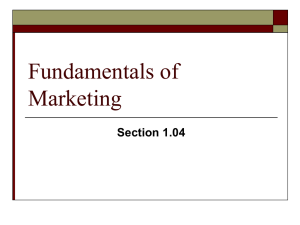Market Segmentation
advertisement

Market Segmentation Chapter 2 Market Segmentation - is the process of dividing the total market into smaller groups seeking similar needs and wants from a product or service. Positioning is the third step of the process. It emphasizes key attributes or benefits that differentiate products in the consumer’s mind. Effectiveness market segmentation has two important features: Positioning is always formulated before marketing mix but is communicated via advertising, hence the order of the chapters. 1. It defines needs wants on which the groups strongly differ; 2. These needs and wants must be capable of being by the firm. Market Segmentation is in contrast to mass marketing or Total Marketing Approach that assumes that everybody has the same needs and wants, and will therefore look for the same products or services. The Market segmentation is evolved from the simple three-tier of price segmentation of consumers into high-, medium-, and lowend. I. • MARKETING MANAGEMENT PROCESS The marketing management process starts with identifying an opportunity, which can come either in the form of either a new or existing product opportunity or a market opportunity. Marketing Management process OPPORTUNITIES MARKET SEGMENTATION POSITIONING MARKETING MIX Principles of Marketing II. MARKET SEGMENTATION Market segmentation enables a company to develop a positioning and marketing mix strategy that can satisfy a smaller, more focused range of customer’s needs and wants given the identified opportunity (this smaller focus is also referred as niche). • It reduces competitive pressure because the firm is focused on its niche or a combination of niche groups seeking similar benefits. • It enables the company to have a better understanding of its target market and employ the best ways to reach them instead of trying to serve all or different markets at the same time. There are various ways to do market segmentation for consumer products: 1. 2. 3. 4. By needs and wants (or benefits) By Socio-demographics By psychographics By consumer behaviour A. Need Segmentation A major way to segment a market is by identifying the needs and wants. Segment market is based on: Hand-outs Market Segmentation Chapter 2 o Component o Taste Preferences or Occasions o Reasons for travel –business, convention of leisure B. Emotive Need Segmentation Most need segmentation is based on consumer’s functional needs. There is another way to do segmentation, and this is via emotive needs classified by market research firm TNS as “Needscope”: o Expressive or how one looks –used by fashion and personal care o Gratification or how one feels –used by food and pharmaceutical products o Combination of how one looks and feels –used by the automotive, telecom products and medical care Brands must establish emotional connection with their customers as this can help identify commonalities better than others traditional segmentation methods. Market Segmentation is not the same as product segmentation C. Socio-Demographic Segmentation Market segmentation most often starts with demographics. Demographics segmentation deals with questions such as “who you are” and “how much do you earn” and is commonly used when planning and allocating selling efforts. During political elections, demographics can be used to plot a candidate’s strategy. In the year 2000 presidential elections of the United States, then Texas Governor George Principles of Marketing W. Bush won over then incumbent vice president Al Gore with support from the following groups based on: • o Religious orientation (63% attends church more than once a week vs. Gore’s 36%) o Geographical difference (59% are rural residents vs. Gore’s Religious orientation (63% attends church more than once a week vs. Gore’s 36%) o Civil Status (53% married vs. Gore’s 44%). Demographic Segmentation Variables D. Psychographics Segmentation Psychographics segmentation is concerned more with answers to questions such as “What you do” (instead of “who you are”) and “How you spend your money “(instead of “How much you earn”) and is now often used for creating advertising messages. Hand-outs Market Segmentation Chapter 2 • • It is done by asking consumers various questions and classifying them according to a cluster of answers. Psychographics segmentation relates to social issues, personal interests, and specific product attributes: Psychographics Segmentation Variables Psychographics Segmentation of Metro Manila Consumers THE SMOOTH SAILERS 34% “The Smooth Sailers are highly sociable, secure and active but conservative. They have a positive self-concept and are security-conscious, and prefer the simple and essential, abhorring complications. Price does not seem to be a very important factor in their buying decisions. “ The Nielsen Company, conducted a lifestyle study in the second quarter of 1990 called “Pulse Lifestyle ’90”. A thousand males and females, 15 to 65 years, representing about 63% of Metro Manila‘s population were involved. o Using a questionnaire, respondents were asked to mention their habits, product consumption, and demographics, and their agreement or disagreement with pyschographics statements. o In analyzing the result, different clusters were formed. Each cluster was examined in relation to lifestyle, product/brand usage, media habits, and demographics. o Finally, an analysis of predictors and determinants of product usage was applied in the preparation of target market reports Principles of Marketing THE HIGH SPIRITS 31% “The High Spirits are the most vibrant and fun-loving. They would like to maintain a high social profile, and appear to be then trendsetters among the five groups. They think positively and do not seem to be the homebody type. They would rather go out with friends than stay at home.” THE TIGHT GUARDS 26% “The Tight Guards have the strongest feelings of inadequacy and uncertainty compared to the others. They are health conscious and are meticulous about personal and family cleanliness. There are slightly more females (55%) than males in the group, and over half of them are married.” THE HOMEMAKERS 5% “These are the most upscale among the five lifestyle groups. The Homemakers have the highest percentage of college degree holders (higher even the average for the population), and slightly more than one-half (55%) of this group belong to class ABC households.” THE BYSTANDERS 4% “The Bystanders are rather passive people, usually “painfully shy” and not too inclined Hand-outs Market Segmentation Chapter 2 to socialize. They may buy “tingi” (by piece). About 9 out of 10 Bystanders belong to the lower income households (class D). They also appear to be the oldest of the five lifestyle groups.” Understanding customer behavior has its obvious applications. For instance: ▫ Customers who tend to be loyal to a brand will most likely not respond to a competitor’s price cut, at least, not immediately. ▫ Place or distribution, display, and packaging can be critical for self-conscious buyers of intimate products such as lingerie and conditions. Psychographics Segmentation of the stomach remedy market: THE SEVERE SUFFERERS “The severe sufferers are the extreme group on the potency side of the market. A cost advanced product with new ingredients best satisfies their need for potency and fast relief, and ties in their psychosomatic beliefs.” THE ACTIVE MEDICATORS “The active medicators are on the same side of motivated spectrum. They are influenced by a brand’s reputation and by how well it is advertised. They tend to develop strong brand loyalties. Behavioral Segmentation Variables THE HYPOCHONDRIACS “The hypochondriacs are on the opposite side of the motivated spectrum. They want a simple, single-purpose remedy that is safe and free from side effects and backed by doctors or a reputable company.” THE PRACTICALISTS “The practicalists are in the extreme position on this side of the motivated spectrum. They seek simple products whose efficacy are well proven, and are skeptical of complicated modern remedies with new ingredients and multiple functions.” E. Behavioral Segmentation Another method of market segmentation is by consumer behavior. Principles of Marketing F. Internet Segmentation For online behavior, Forrester Research released their North American Technographics Empowerment Survey done in 2009 with the following behaviour segments of the internet audience: Inactives (17%) Spectators or those who simply read listen or watch online content (70%) Hand-outs Market Segmentation Chapter 2 Joiners or those who maintain a profile on social networking sites (59%) Collectors or those who use RSS feeds, vote for websites online or add “tags” to web pages or photos (20%) Critics or those who comment on somebody else’s blog, forums, or rate products and services. (37%) Conversationalists or those who post updates on social networking sites (33%) Creators or those who share personal blogs, web pages or video or music they created (24%) G. Price Segmentation Profitability is Key All possible market segments must be considered and reviewed periodically with the best being the segment that offers the highest profitability in relation to the return on investment. • What is relevant is not the quantity sold but what quantity has been sold at a profit. The firm should use an objective set of criteria to shortlist their desired market segments. Such as: o o o o o o o Marketers can always do segmentation by price. There will always be buyers who are quite price sensitive, especially in an economic slowdown and buyers who are just the opposite, especially in an economic boom. Market size Market growth Homogeneity Cost of creating awareness Purchase of authority Loyalty Level Responsiveness of customers • The demand of industrial clients is inelastic, or quantity may not change despite changes in price and may fluctuate accordingly to the business climate. Industrial or business-to-business segmentation III. MARKET MEASUREMENT A market is composed of customers and competition. It has a group of actual and potential buyers with similar needs and wants interacting with sellers offering various products or services to satisfy those needs and wants. There are two criteria for market attractiveness: 1. Market size 2. Market growth Market size is dependent on the number of qualified customers and the frequency of purchase. Principles of Marketing Hand-outs Market Segmentation Chapter 2 Qualified customers within a market would have the following characteristics with the acronym N-P-A: o by region • 1. Need The need characteristic answers the question “How many percent of the market would need the product?” • 2. Pay Consumer need or interest is not enough. There must be enough purchasing power for the consumer to be able to pay for the product. 3. Authority and Availability Persons below 18 years of age, for example, are not legal market for cars and alcoholic beverages. They have no authority to use these products. o Products not distributed in certain localities further reduce the market size. Research suppliers For fast moving products such as food and beverages, and personal care products, one way to know which market segment to tap, to recognize market trends and to understand market size is through “ retail audit” reports from Neilsen. • The retail audit reports summarize sales and market shares of over 100 product categories in several ways: o by brand, • It also provides information about distribution and inventory levels (including out-of-stock incidence), and both buying and selling prices of retailers. Retail audit reports do not include products bought via direct sales and online, hence, TNS (a research firm) offers Home Panel research service. A complete list of marketing research firms like: 1. TNS 2. Neilsen 3. Philippine Survey and Research Center 4. Milward Brown 5. Synovate 6. Saffron Hill 7. Marketing and Opinion Research Society of the Philippines (MORES) Industrial Products Market Measurement Total industry sales and not individual company sales are reported to maintain confidentiality for each company in the same industry. For imported products or products with imported ingredients, a summary of import manifests supplied by importation research companies may be used to estimate demand and track competitive movement. o by product group, o by type of store, and Principles of Marketing Hand-outs Market Segmentation Chapter 2 Estimating market demand for canned sandwich spread and light beer • BASES enable marketers to choose from among six to 10 simulations to get the best possible desired result. How BASES works Estimating the demand for canned spread by multiplying all the variables involved in the market: 1. Total population 2. Total purchasing power 3. Average expenditures on food 4. Average expenditures on food that is spent on processed food. 5. Average expenditures on processed food that is spend on canned food 6. Average expenditures on canned food that is spent on canned spread BASES has a property set of calibrations which are used to compensate for consumer overstatement and understatement so that a realistic evaluation of future behaviour is obtained. Target Market The target market is a fairly homogenous group of people or organizations to whom a company wishes to appeal • Target Market Planning or TPlanning enables the marketing and product development group to focus on a target for both product and communications effort. • Primary Target Market (PTM) BASES Model (Burke’s Advanced Sales Estimating System) • BASES predicts the sales of new or re-launched products • It is capable of forecasting the sales of line extensions when a new variety, size, or pack format is introduced. Principles of Marketing -who are most logical buyers who should generate the bulk of sales. • Secondary Target Market (STM) -who must also be reached through different communications and marketing mixes. Hand-outs








